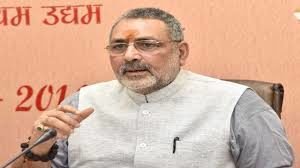Correspondent
New Delhi: History is an indispensable part of every Indian election. To be precise, it is the distortion of historical events that has become an inseparable part of the poll process as has been on display in the Delhi election campaign. The latest to join the league was  leader and union minister Giriraj Singh. On Thursday, Singh, referring to the recent death of an infant at Shaheen Bagh, lambasted the women-led anti-CAA protest and dubbed it “Khilafat Movement Part II”. “What is happening at Shaheen Bagh is Khilafat Part II. The Khilafat Andolan was started by Jinnah and the PFI wants this. This is not a protest against CAA, because if it was, then there would be a dialogue. They (Shaheen Bagh protesters) want to turn India into an Islamic State, just like what Sharjeel Imam has said and AAP leaders are turning this into their vote bank.”Singh went on to rebuke the mother who recently lost her infant to the harsh winter, and compared the death of her child to suicide bombing.
leader and union minister Giriraj Singh. On Thursday, Singh, referring to the recent death of an infant at Shaheen Bagh, lambasted the women-led anti-CAA protest and dubbed it “Khilafat Movement Part II”. “What is happening at Shaheen Bagh is Khilafat Part II. The Khilafat Andolan was started by Jinnah and the PFI wants this. This is not a protest against CAA, because if it was, then there would be a dialogue. They (Shaheen Bagh protesters) want to turn India into an Islamic State, just like what Sharjeel Imam has said and AAP leaders are turning this into their vote bank.”Singh went on to rebuke the mother who recently lost her infant to the harsh winter, and compared the death of her child to suicide bombing.
“Look at what that mother did to her baby. She took the baby out in the cold and it was killed. If this is not suicide bombing, then I don’t know what is.”Before this, the minister had also tweeted that Shaheen Bagh is no longer just a movement, but “a breeding ground for suicide bombers”. “It is a conspiracy against the country in the capital. Listen to these children. The poison that is being filled in their minds. What else is there, if not the Khilafat Movement.”The statement reflects nothing but an attempt at historical negationism, designed to further polarise the electorate. The protests against the CAA and NRC, in which Muslims have asserted their identity as Muslims and Indians, have seen commentators draw parallels to the Khilafat movement, in which Mahatma Gandhi had used a Muslim grievance to launch a nationwide movement against the British.
But by giving it the imaginary figurehead of Jinnah, Giriraj Singh is ensuring that the BJP’s dominantly Hindu voter base has a very different, and a more communal, image of the protests. The Khilafat movement, a campaign that called for the restoration of a caliphate spread across several countries, had started in 1919. It had gained traction in India only after Mohandas Karamchand Gandhi had fused the pan-Islamic agitation with the Non-Cooperation Movement. Contrary to Singh’s claim that the agitation was led by Jinnah, it was launched by the Ali brothers — Shaukat and Muḥammad — and Abul Kalam Azad. In fact, Jinnah had very little to do with the entire movement. While Jinnah was away in England, Gandhi had changed his tactics and united Hindus and Muslims by espousing a Muslim-only religious cause: the ‘Khilafat’. Jinnah was especially opposed to befriending radical Muslim leaders and felt it would be nothing short of disaster for the country.
Jinnah’s vociferous objection to Gandhi’s decision to embrace radical Muslims and join the Khilafat movement is extensively discussed in author Sheela Reddy’s book “Mr & Mrs Jinnah”. Reddy’s book delves into the Indian society and politics of the second and third decades of the 20th century. In 1919, fears of Muslim disunity soared following the decline of the Ottoman Empire after its defeat in World War I. The Ottoman Sultan, the caliph, was seen as the leader of Muslims worldwide. In India, the Ali brothers joined forces with Gandhi’s Non-cooperation movement to further their cause. In return for Gandhi’s support, the Ali brothers vowed non-violence.
Meanwhile, Jinnah was pushing his Muslim League office-bearers to organise a special session in order to assess the situation and distance themselves on the Khilafat cause. But, it became a futile exercise as Gandhi was poised to take over the Congress, with his Khilafat allies supporting him.
However, the Khilafat movement took a hit in 1920 (when the agitation was at its height) with the “ḥijrat” (exodus) movement when thousands of Muslims migrated to Afghanistan, under the impression that India was an apostate land. The Khilafat movement was also marred by the Muslim Malabar rebellion in South India in 1921. But, the final blow was served when Gandhi withdrew Non-Cooperation movement following the Chauri Chaura incident and got arrested in March 1922. The movement finally collapsed with the abolition of the caliphate in 1924.
Enter the text or HTML code here


